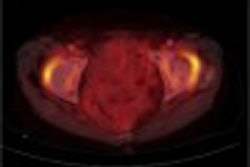In a report slated for the February issue of Radiology, Dr. Harry Agress, Jr., and Dr. Benjamin Cooper summarized the findings of 53 patients who had unexpected foci of hypermetabolism after whole-body FDG-PET scans.
Dear Molecular Imaging Insider,
As imaging modalities go, FDG-PET offers more than its share of surprises. The technique is used most commonly to stage known cancers, or to determine the malignant potential of lesions that were discovered using other modalities.
But an important additional benefit of FDG’s avidity to hypermetabolism is its ability to detect unexpected malignant and pre-malignant neoplasms other than the primary tumor for which the patient was scanned, according to Dr. Harry Agress, Jr.
In a report slated for the February issue of Radiology, Agress and co-author Dr. Benjamin Cooper summarized the findings of 53 patients who had unexpected foci of hypermetabolism after whole-body FDG-PET scans. By flagging the hot spots, the physicians spurred the identification of 30 completely unsuspected malignant or premalignant tumors.
In an interview with staff editor Tracie L. Thompson, Agress discussed his efforts to convince other physicians of the importance of these unexpected PET findings -- and determined that dogged persistence was key.
As a Molecular Imaging Insider subscriber, you have access to this story before it’s published for the rest of our AuntMinnie.com members. To read more about Agress’ findings and advice to other PET clinicians, go here.
If you haven’t done so in awhile, be sure to stop in and check out our online textbook, Nuclear Medicine on the Internet, here.
This online e-book, authored by Dr. Scott Williams of Advanced Radiology Consultants in Bridgeport, CT, is updated each month to ensure you get the latest news on clinical investigations and techniques for the entire spectrum of molecular imaging.



















